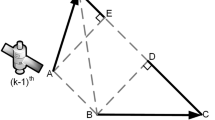Abstract
To improve the low accuracy of multiple frequency-hopping (multi-FH) signals sorting under complex electromagnetic environment and low signal-to-noise ratio, this paper proposes a multi-FH signals sorting algorithm based on the problems of mixed matrix time varying, existing collision FH signal and frequency switching time in the actual FH communication system. Firstly, received signals are converted to time–frequency domain by using short-time Fourier transform. After the time–frequency signals are subjected to adaptive noise reduction, the time–frequency information is extracted through the frequency clustering algorithm. Secondly, it combines the characteristics of the interference signals such as fixed-frequency signals and swept-frequency signals. Then, the direction of arrival (DOA) of each FH signal is estimated, and the multi-FH signals are initially sorted according to the frequency dwell time and DOA. Time of arrival algorithm based on center of gravity is adopted to sort specific source signals, which have same dwell time and DOA. Finally, the collision signal is located by scanning the switching time of each sorted FH signals, and the suitable class is found based on the estimated DOA and the hopping time. Ultimately, the frequencies of each source signal are sorted out. The experimental results show that the accuracy of multi-FH sorting is above 90% in the complex electromagnetic environment, which improves the low multi-FH sorting accuracy of actual FH system under the condition of existing synchronous and asynchronous FH signals.












Similar content being viewed by others
References
E.J. Candes, J. Romberg, T. Tao, Robust uncertainty principles: exact signal reconstruction from highly incomplete frequency information. IEEE Trans. Inf. Theory 52, 489–509 (2006)
L. Chen, Y. Wang, E. Zhang, A real-time sorting method for non-orthogonal frequency hopping signals. Electron. Warf. 6, 18–21 (2008)
T.C. Chen, Joint singal parameter estimation of frequency-hopping communications. IET Commun. 6(4), 381–389 (2012)
W. Fu, Y. Hei, X. Li, UBSS and blind parameters estimation algorithms for synchronous orthogonal FH signals. J. Syst. Eng. Electron. 25(6), 911–920 (2014)
W. Fu, D. Li, The convolution blind separation algorithm based on filter order estimation. J. Huazhong Univ. Sci. Technol. (Nat. Sci. Ed.) 46(6), 116–121 (2018)
H.A. Huynh, Y. Han, S. Park et al., Design and analysis of the DC–DC converter with a frequency hopping technique for EMI reduction. IEEE Trans. Compon. Packag. Manuf. Technol. 8(4), 546–553 (2018)
C. Li, H. Yang, S. Fan et al., Adaptive overhearing in two-way multi-antenna relay channels. IEEE Signal Process. Lett. 23(1), 117–120 (2016)
K. Lee, S. Oh, Detection of fast frequency-hopping signals using dirty template in the frequency domain. IEEE Wirel. Commun. Lett. 8(1), 281–284 (2018)
E. Lagunas, M. Nájar, M. Navarro, Joint TOA and DOA estimation compliant with IEEE 802.15. 4a standard, in 5th International Symposium on Wireless Pervasive Computing (IEEE, 2010), pp. 157–162
X. Liu, N. Sidiropoulos, A. Swami, Joint hop timing and frequency estimation for collision resolution in FH networks. IEEE Trans. Wirel. Commun. 4(6), 3063–3074 (2005)
S. Li, B. Feng, An asynchronous FH radio sorting algorithm based on geometry transform. Radio Eng. 7, 21–23 (2015)
T. Rothman, Random paths to frequency hopping. Am. Sci. 107(1), 46–53 (2019)
Z. Sha, Z. Liu, Z. Huang, Online hop timing detection and frequency estimation of multiple FH signals. ETRI J. 35(5), 748–757 (2013)
Z. Sha, Z. Huang, Y. Zhou et al., Frequency-hopping signals sorting based on underdetermined blind source separation. IET Commun. 7(14), 1456–1464 (2013)
D. Torrieri, Principles of Spread-Spectrum Communication Systems (Springer, Heidelberg, 2011)
L. Wan et al., PD source diagnosis and localization in industrial high-voltage insulation system via multimodal joint sparse representation. IEEE Trans. Ind. Electron. 63(4), 2506–2516 (2016)
L. Wan et al., The critical patients localization algorithm using sparse representation for mixed signals in emergency healthcare system. IEEE Syst. J. 12(1), 52–63 (2018)
X. Yu et al., A network sorting algorithm based on blind source separation of multi-FH signal. J. Signal Process. 33(8), 1082–1089 (2017)
X. Yu et al., Efficient 2D-DOA estimation algorithm for multi-FH signals. Syst. Eng. Electron. 40(6), 1363–1370 (2018)
C. Yang, L. Sun, B. Zhu, Based on independent component analysis of the frequency-hopping station sorting. Ship Electron. Eng. 288(6), 46–50 (2018)
L. Zhou, D. Peng, H. Liang et al., Generalized methods to construct low-hit-zone frequency-hopping sequence sets and optimal constructions. Cryptogr. Commun. 9(6), 1–22 (2017)
C. Zhang, Y. Wang, F. Jing, Underdetermined blind source separation of synchronous orthogonal frequency-hopping signals based on tensor decomposition method. IEEE Access. 6, 69407–69414 (2018)
J. Zhao, J. Yang, J. Jin, DOA estimation based on JADE algorithm. J. Commun. 31(8), 91–97 (2010)
Acknowledgements
We gratefully acknowledge anonymous reviewers who read drafts and made many helpful suggestions. This work is supported by National Nature Science Foundation of China (61201134).
Author information
Authors and Affiliations
Corresponding author
Additional information
Publisher’s Note
Springer Nature remains neutral with regard to jurisdictional claims in published maps and institutional affiliations.
Rights and permissions
About this article
Cite this article
Fu, W., Hu, Z. & Li, D. A Sorting Algorithm for Multiple Frequency-Hopping Signals in Complex Electromagnetic Environments. Circuits Syst Signal Process 39, 245–267 (2020). https://doi.org/10.1007/s00034-019-01160-8
Received:
Revised:
Accepted:
Published:
Issue Date:
DOI: https://doi.org/10.1007/s00034-019-01160-8




